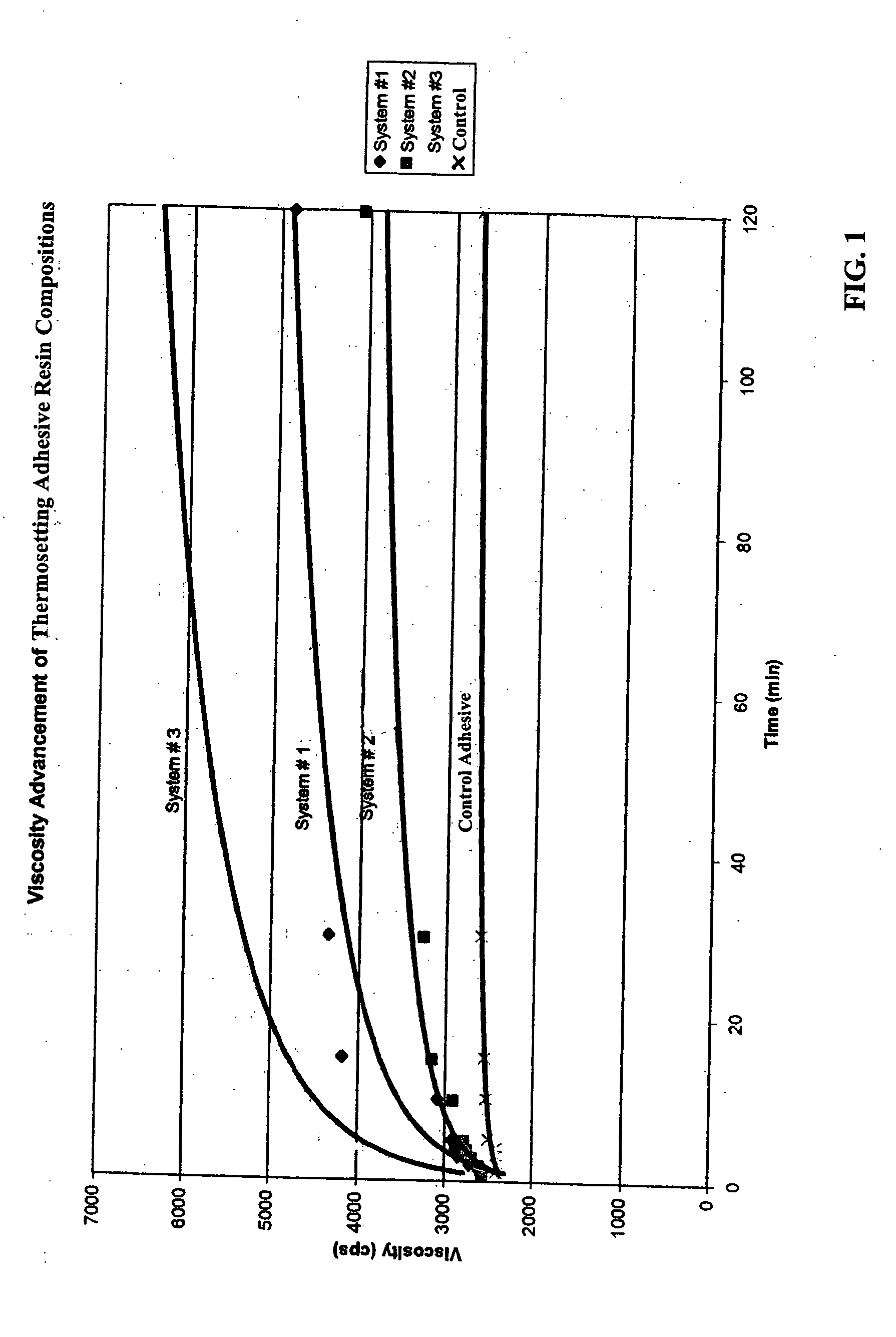Phenolic resin-based adhesives and methods of using same in preparing laminated veneer lumber (LVL)
- Summary
- Abstract
- Description
- Claims
- Application Information
AI Technical Summary
Benefits of technology
Problems solved by technology
Method used
Image
Examples
example 1
[0053] A comparison was made among several adhesive compositions, in terms of the bonding strengths obtained in the preparation of LVL billets. Preparation conditions used for these comparative tests, including pre-pressing and hot-pressing conditions were maintained as close to the same as possible and within the standard conditions recited herein. The phenol-formaldehyde (PF) component of the adhesive used in each test had Mn, Mw, and Mz values ranging from about 450-550 g / mol, 2200-3000 g / mol, and 6000-8900 g / mol, respectively. An acetone-formaldehyde (AF) resin cure promoter was added to the adhesive composition in varying amounts. Adhesive bond quality was analyzed according to ASTM D-5266-97 (Standard Quality Practice for Estimating the Percentage of Wood Failure in Adhesive Bond Joints), which measures the wood failure percentage when the glue line of an LVL sample is sheared apart. Thus, a higher wood failure rate is indicative of a lower adhesive failure rate and directiona...
example 2
[0055] Two LVL billets were made according to essentially identical and standard procedures described herein. The adhesive used to prepare the LVL billets comprised a PF resin-based adhesive mixture, as described in Example 1, which was combined with an AF resin-based cure promoter mixture, as described in Example 1 and a triacetin catalyst. These components were combined in weight ratios of 88.8 / 10 / 1.2 (Billet 1) and 81 / 18 / 1 (Billet 2), of PF resin-based adhesive mixture / AF resin-based cure promoter mixture / triacetin. Billet 2 showed improved bonding relative to the Billet 1, according to ASTM D-5266-97, described in Example 1. This example further demonstrates the direction improvement in bonding strength achieved as AF resin cure promoter is added to the adhesive composition.
example 3
Bonding of Catalyzed and Uncatalyzed Adhesives to Different Moisture Veneers
[0056] This example demonstrates the diversity of adhesive compositions of the present invention in performing under a variety of veneer moisture levels ranging from dry (2% veneer moisture) to moderate (7% veneer moisture) to wet (12% veneer moisture) conditions. A designed experiment (Box Behnken) was carried out using the PF resin-based adhesive mixture (1) as described in Example 1 (i.e., the designated Control Adhesive) and mixture (3) as described in Example 1 (i.e., the designated Present Invention Adhesive, namely, a PF resin-based adhesive mixture, combined with an AF resin-based cure promoter mixture in a weight ratio of 80 / 20 PF resin-based adhesive mixture / AF resin-based cure promoter mixture). Under the designed experiment, the amount of adhesive applied to the glue lines of the composites ranged from 29 to 40 lbs / 1000 square feet of single glue line (lb / Mft2 SGL), and the hot press time at 31...
PUM
| Property | Measurement | Unit |
|---|---|---|
| Temperature | aaaaa | aaaaa |
| Temperature | aaaaa | aaaaa |
| Temperature | aaaaa | aaaaa |
Abstract
Description
Claims
Application Information
 Login to View More
Login to View More - R&D
- Intellectual Property
- Life Sciences
- Materials
- Tech Scout
- Unparalleled Data Quality
- Higher Quality Content
- 60% Fewer Hallucinations
Browse by: Latest US Patents, China's latest patents, Technical Efficacy Thesaurus, Application Domain, Technology Topic, Popular Technical Reports.
© 2025 PatSnap. All rights reserved.Legal|Privacy policy|Modern Slavery Act Transparency Statement|Sitemap|About US| Contact US: help@patsnap.com


